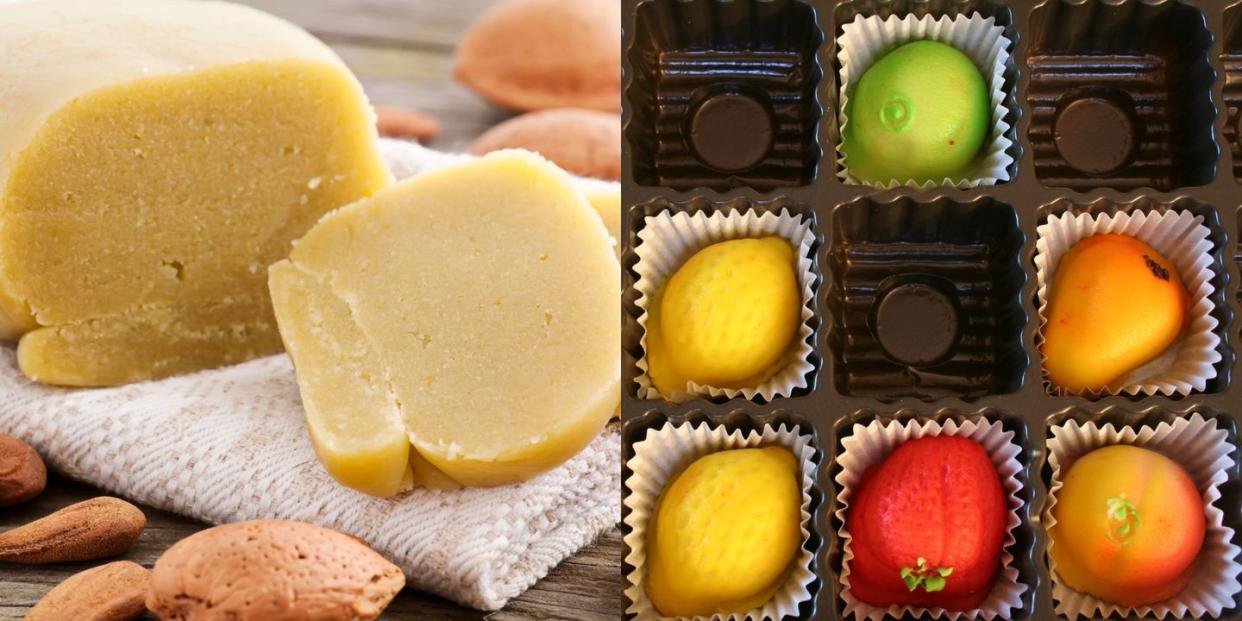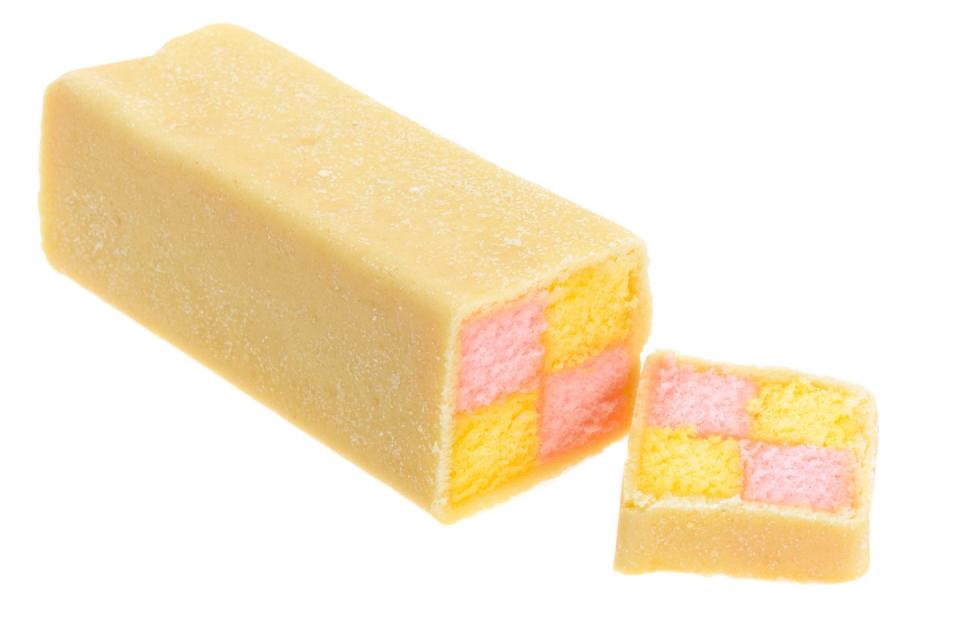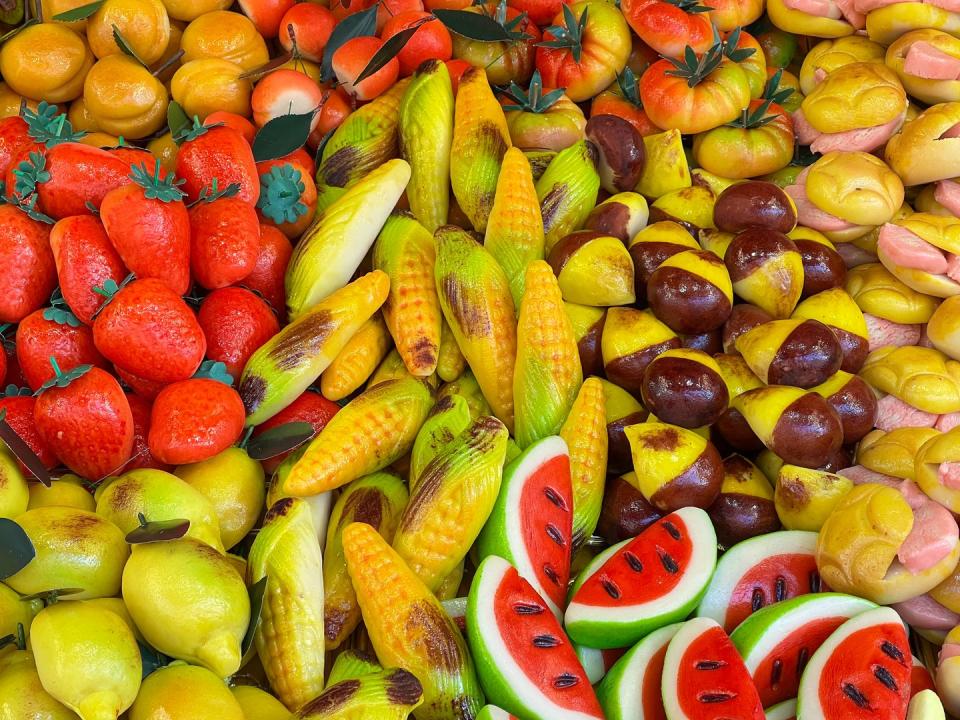Ever Seen Those Tiny Fruit-Shaped Desserts? They're Made With This Magical Ingredient

"Hearst Magazines and Yahoo may earn commission or revenue on some items through these links."
If you watch The Great British Bake Off, like to look at the display cases in Italian bakeries, or shop for holiday candy, you've probably encountered marzipan. It can be sandwiched between cake layers or molded and painted to resemble miniature fruits. But what exactly is it, anyway? And what purpose can it serve in your cooking? We consulted some chefs and authors to find out everything you need to know about marzipan.
Jump to:
What Is Marzipan?
Marzipan is, in the simplest terms, a sugar and almond paste. It's a common confection across Europe and has been used for centuries as both a sweet treat and a medium for food art. "In Renaissance Venice, confectioners not only had to know how to concoct a batch of marzipan but were expected to be skilled sculptors, sometimes working hand in hand with noted artists to create ornate sugary monuments," writes Michael Krondl in his book Sweet Invention: A History of Dessert.
Different regions of Europe claim to be the official experts of marzipan, like Toledo in Spain, Palermo in Italy, and Lübeck in Germany. However, since the tradition is rooted in nearly 100 years of history, it's hard to pin down exactly when, where, and how marzipan came to be a dessert staple.
Recipes can vary based on the region, but the two ingredients you'll always find in marzipan are blanched almonds and sugar. They combined and ground into a paste, wuth the natural fat from the almonds creating a rich emulsion. From there, it can be flavored with honey, almond extract, or even rose water.
"More or less a novelty item outside of Europe, Marzipan has been used for a variety of European pastries and cakes for hundreds of years," writes Nicole Spohn in her book German Christmas Cookies & Other European Holiday Treats. "Marzipan was ubiquitous as a confection but also as an ingredient in other dishes," writes Krondl.
Marzipan is less common in the United States than it is in Europe. Its association with old-fashioned European pastries has earned it a reputation as a slightly outdated holiday dessert—reflected in this recent Saturday Night Live sketch. But that doesn't mean it deserves a bad rap. It can be enjoyed not only on its own but also as a rich, moist addition to any kind of baked good.
How To Use Marzipan
Marzipan is often used as a protective coating on the exterior of cakes to trap in moisture and prevent your pastries from drying out. One prime example you may have seen on The Great British Bake Off is the classic English Battenberg cake. Not only does the marzipan add a nutty flavor and source of moisture, it also acts as a layer of security to hold together the cake slices arranged in a checkerboard pattern.

It can also be incorporated into doughs and batters before going into the oven. Marzipan provides doughs with sweetness as well as a uniquely nutty flavor. At many bakeries, almond croissants are stuffed with a layer of marzipan for a dense, sweet center.
While it can be incorporated in a wide variety of pastries, marzipan is most notably served on its own as a confection around the holidays. It's most commonly sold at Italian bakeries and other European specialty stores and can come in different shapes. Marzipan can be molded into the form of a pig, a miniature loaf of bread, or multiple types of fruit. This tradition dates back centuries, but became especially common in Italy during the Renaissance.

Because of its pliable texture, it also works well as a material to create cake decorations. Think of it as an old-school fondant, it can be molded and shaped into flowers and decorative trims to add extra oomph to your desserts.
How To Store Marzipan
Because of its relatively shelf-stable ingredients, marzipan can be stored, unopened, for months at room temperature. Once you open it, it can stay in your pantry for up to three weeks. It's important to keep it in an airtight container or wrapped well in plastic to prevent the moisture from evaporating.
Substitutes
Marzipan is a unique ingredient that can come in many variations. However, if you're unable to find it at the grocery store or online, you're better off making it from scratch. Our friends at Delish UK have a great recipe that you can use here.
Marzipan can often be confused with almond paste. They're both made of the same ingredients—but they are absolutely not the same. Almond paste is much coarser and less sweet in flavor. It's meant to be used as a baking ingredient and cannot be enjoyed on its own.
If you're looking for a decorative trim for the outside of your cakes, you can substitute marzipan for store-bought fondant. However, if you're planning on incorporating marzipan inside baked goods or forming your own fruit-shaped candies, there are no substitutes for this special ingredient.
You Might Also Like

